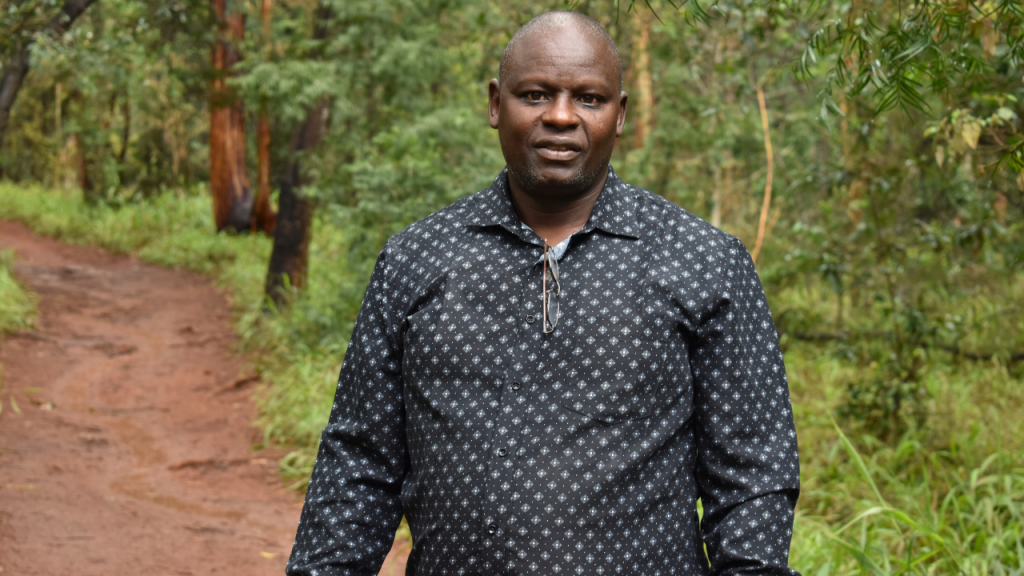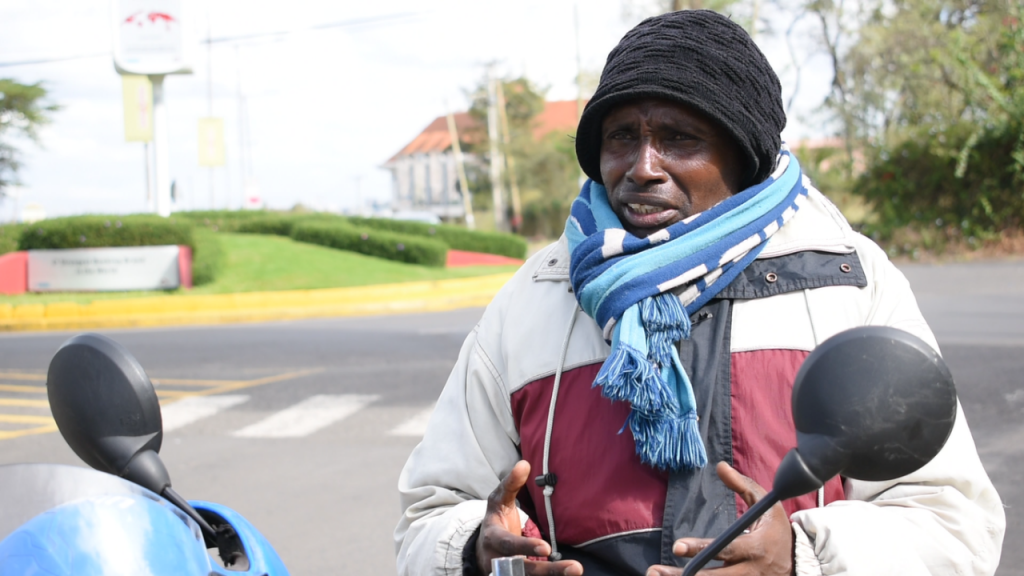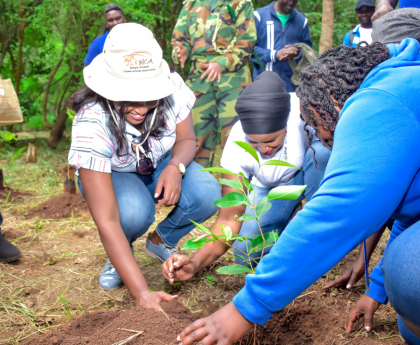In the heart of Upperhill, Nairobi, Ronald Onyinkwa Matoke has become a familiar figure, skillfully maneuvering through the bustling commercial hub as a motorcycle taxi rider (boda-boda).
He is one of more than 176,00 registered boda boda riders in Nairobi’s capital, a fraction of the estimated 1.4 million registered motorcycles in the country. But Matoke has developed a persistent headache and at the end of each day he is unusually tired.

Matoke states, “In my opinion, I would affirm that boda-bodas contribute to air pollution. However, it’s not just confined to motorcycles; you can also observe cars emitting harmful exhaust, as well as industries.”
Motorbike emissions are primarily responsible for the deteriorating air quality in the city, and according to experts, these emissions, including carbon monoxide and hydrocarbons, are not only degrading air quality but also posing an immediate threat to those who breathe the polluted air.
“Much like cigarette smoking, inhaling this polluted air over extended periods can result in chronic health conditions,” said Dr. Waweru Munyu, a pulmonologist based in Nairobi. “Short-term effects include immediate symptoms like sneezing, coughing, chest tightness, and wheezing when exposed to this polluted air.”
Dr. Munyu said that the prolonged exposure to vehicular emissions increases the chances of chronic obstructive pulmonary disease (COPD), cardiovascular issues, strokes, and even cancer.

“People living near high-traffic areas, professionals like boda-boda riders, drivers and mechanics, face elevated risks of lung infections and asthma due to constant exposure to vehicular emissions.” Munyu said.
“Nairobi experiences approximately 28,000 deaths due to air pollution annually, including 1,000 premature deaths within the city alone,” stated Dr. George Mwaniki, Head of Air Quality at the World Resources Institute (WRI) Africa.
Dr. Mwaniki highlighted the broader issue of air pollution in Africa, where approximately 1.5 million people (about the population of Mombasa city) lose their lives annually, an alarming statistic equivalent.

The World resources institute (WRI) under the Clean Air Catalyst, an Air Quality program flagship, confirms that Vehicular emissions are the largest contributors to air pollution in Nairobi, indicating that ‘Air pollution in Nairobi has worsened 180 times since independence in 1963, far surpassing neighboring cities such as Kampala’
Nairobi’s Air Quality Monitoring Analysis
Dr. John Birir, from the University of Nairobi’s Institute of Nuclear Science and Technology, notes significant variations in pollution levels between day and night in Nairobi.

“Pollution tends to spike during rush hours, particularly in roundabouts due to frequent vehicle starts and stops, leading to incomplete combustion,” Dr. Birir said.
Birir is worried about tiny particles, especially PM2.5, which are over 30 times thinner than a human hair and pose significant health risks when inhaled.

Unfortunately, Nairobi’s PM2.5 levels are much higher than the World Health Organization’s recommended annual limit of 5 micrograms per cubic meter, raising serious health concerns.
Dr. Munyu warns, “When we breathe in these tiny particles, they penetrate deep into our lungs and even enter the bloodstream, which is harmful.”
The Global South State Concerns:
Meanwhile, the World bank states that ‘people in low- and middle-income countries are most affected by mortality and morbidity from air pollution. The death rate associated with air pollution is significantly higher in low-and lower-middle income countries than in high-income countries.’
The analysis estimates that the global cost of health damages associated with exposure to air pollution is $8.1 trillion, equivalent to 6.1 percent of global GDP. according to the world bank publication, 2022.
Anumita Roychowdhury, Executive Director of the Center for Science and Environment (CSE) in India, shares her observations, saying, “When I came to Nairobi, what strikes me as special is the common challenge that we face in the Global South. I come from India, and I know what the air pollution challenges are.”
During the launch of the State of Africa’s Environment Report 2023, Roychowdhury said that, despite lower vehicle ownership compared to other regions, Africa is witnessing a rapid increase in vehicle numbers. She points out that “about 80 to 90% of vehicles in this region are old, contributing to increased emissions.”

She highlighted research findings that across Africa, 14% of all deaths in children under the age of 5 are linked to air pollution.
The report underscores the long-term consequences for newborns and infants, stating, “The impact on newborns and infants also has long-term consequences for overall health, including issues with lung development and increased susceptibility to communicable diseases such as lower respiratory infections in young children.”
Jane Akumu, the Africa focal at the UN Environment, emphasizes the challenge of Africa’s dependence on imported used vehicles.
“These vehicles often lack compliance with modern emission standards and safety requirements, as they are not subject to a stringent age limit.” Akumu said, noting that they are more prone to high levels of pollution due to outdated engine technology and insufficient emissions control.
Akumu said that planning and sustainable mobility pose critical challenges for African cities.

“Importing such vehicles not only exacerbates air pollution but also carries economic implications, including increased maintenance costs and a higher likelihood of breakdowns, significantly impacting the overall cost of vehicle ownership,” she said.
The gendered aspect of Air pollution:
Dr. Waweru Munyu, emphasized the occupational risks, stating, “Certain careers, such as jobs in the transport industry, dusty factories, or garages, where men are more commonly employed, can lead to long-term lung conditions due to exposure to airborne substances without proper protection.”
Dr. Munyu highlighted the vulnerability of men to the health effects of air pollution and underscored, “Air pollution exerts a disproportionate toll on women, especially those in their childbearing years.”
A study published by National library of Science indicated ‘Air pollution is a dangerous factor for pregnant women and newborns, many of whom are highly exposed to traffic-related atmospheric pollutants in urban areas.’ The study warned of potential consequences such as low birth weight, respiratory diseases, and premature death.
“We have to understand the special vulnerability of some sections of the population, and particularly the women, children, and elderly,” said Anumita Roychowdhury.
Roychowdhury pointed out the double burden faced by women and children, explaining, “They are not only inhaling pollution outside but also indoors, as many are still cooking and using stoves where they burn solid fuel, and the smoke fills up their homes.”
E-mobility as part of the solution
In the ongoing efforts to combat the escalating air pollution crisis in Nairobi, the adoption of electric mobility is gaining momentum.
Electric mobility (E-mobility), encompassing electric vehicles (EVs) and e-bikes, stands out as a promising solution to mitigate vehicular emissions and enhance air quality.

Numerous initiatives in Nairobi and across the continent actively work towards the transition to electric vehicles and sustainable transportation options.
Celeste Tchetgen Vogel, CEO and Co-Founder of eWAKA, an E-mobility company in Nairobi, envisions electric mobility as a transformative force, stating, “Electric mobility can be for Africa what the smartphone was for Africa. It has the potential to transform the way we live, do business, and move within our cities.”
Vogel emphasizes the urgent need to address air pollution in cities, asserting, “It’s a health issue, and people are losing their lives because of it.”

Alongside the imperative of reducing air pollution, she underscores the broader impact on economic opportunities and job creation.
Highlighting Kenya’s curiosity about electric mobility, Vogel notes that it has positioned the country as a leader in the industry. She emphasizes, “Curiosity is an important factor in promoting sustainable transportation.”
However, Vogel highlights a crucial challenge related to batteries, stating, “There’s an obsession with range, how far can the E-bike go before it shuts down.” She urges a shift in focus towards public charging points and a well-planned approach to infrastructure.
Kennedy Mutava, the lead mechanical engineer at Kiri EV Limited, a Nairobi-based E-mobility industry, discusses two primary charging approaches: battery swapping and ownership of the battery.
Mutava emphasizes the importance of understanding these choices within the electric mobility sector, allowing consumers and businesses to make informed decisions based on their specific needs and preferences.

“Electric mobility is not only an eco-friendly solution but also a cost-effective mode of transport, contributing to societal benefits by making lives more affordable and healthier.” he said, adding that Charging an electric motorbike at home is more affordable than operating a petrol bike for the same distance.
Jane Akumu, stresses the practicality of electric vehicles.
“Electric vehicles can be charged at night when there’s excess electricity and less demand, making them suitable for areas with intermittent power supply.” Akumu said.
At the Africa Climate Summit 2023, the government made a firm commitment to expedite the adoption of e-mobility as a strategic measure to combat greenhouse gas emissions.
President William Samoe Arap Ruto said that “The adoption of electric mobility is a high-priority intervention to address the challenges of pollution, adverse health effects, and fuel costs.”
E-mobility continues to hold a central position in Kenya’s National Climate Change Action Plan, aligning seamlessly with the Nationally Determined Contribution (NDC) target to reduce Greenhouse Gas (GHG) emissions by 32% by the year 2030.
According to a report from The Energy and Regulatory Authority (EPRA), the transport sector currently contributes approximately 13% of total emissions, underscoring the imperative to transition to sustainable, healthier, and environmentally friendly modes of transport, notably electric vehicles,
To address the escalating challenges of air pollution and environmental concerns in city centers, experts emphasize the need for a comprehensive, multi-faceted approach.
Karura as a nature-based solution: Karura as a nature-based solution:
On an isolated trail stretch within Karura Forest, surrounded by towering trees and the melodious sounds of birdsong, Peter Njui, Operational Manager of The Friends of Karura, a Community Forest Association, directed a ranger perched on an electric motorcycle.

To the casual observer, this motorcycle the ranger was riding seemed like just another two-wheeler on the road — however, as it silently glided away, there was no struggle to kickstart it, no roar of an engine, and before you knew it, the ranger had effortlessly sped off.
“Our rangers use electric motorbikes to patrol and manage Karura’s forests and natural resources,” Njui remarked with satisfaction. “We champion for the use of non-carbon-emitting motorcycles and vehicles in the forest to set an example for reduced emissions.”
Amidst the rhythmic sway of trees and the soothing ambiance of a rainy afternoon, it’s easy to overlook that Karura Forest is nestled in the heart of one of Africa’s largest cities. Encompassing over 1,000 acres, Karura Forest serves as a crucial nature-based solution, boasting diverse plant species that act as a natural filter and contribute to carbon sequestration.

“We abstain from using motorized or petrol/diesel machines in the forest to prevent increased carbon emissions,” said Njui, who noted that, “For visitors to Karura Forest, we encourage carpooling to minimize the number of vehicles and emissions within the forest.”
James Mwang’ombe Mwamodenyi, Principal Conservator of Forests and Head of Biodiversity at Kenya Forest Service (KFS), attributes the preservation and restoration of Karura Forest to the robust partnership between the government and the community.
“Community-led initiatives play a crucial role in clearing invasive species and planting indigenous trees, fortifying the forest against pollution,” he noted, emphasizing the pivotal role of a healthy forest in improving air quality.
“In Karura Forest, moss growing on trees helps trap particles from the air, making the surrounding air fresher for nearby residents.” Mwamondenyi said.
Moss, a small, non-flowering plant forming a dense green carpet on various surfaces, lacks a vascular system but possesses a unique ability to absorb and trap airborne particles, playing a crucial role in environmental processes.

While Karura Forest is a sanctuary, caution is advised against excessive pollution, which can adversely impact the trees.
“Despite biodiversity playing a crucial role in capturing pollutants, high emission levels can hinder its pollution-clearing abilities, leading to adverse consequences,” Mwamodenyi cautioned.
Ongoing efforts are in place to preserve Karura Forest. The Kenya Forest Service conducts continuous tree planting sessions to uphold the forest’s health and resilience.
Njui underscored conservation efforts, stating, “We organize tree planting sessions to preserve the forest’s health and resilience.”
The community actively engages in these initiatives, with women taking the lead in cultivating tree nurseries in Karura, producing seedlings for sale.

Taking control now
While experts acknowledge the challenges of controlling air pollution in already affected cities, immediate actions can be implemented to reduce air pollutants.
Dr. George Mwaniki, sees significant potential in E-mobility, stating, “E-mobility is one area with a lot of potential to reduce air pollution in the country because around 95% of our electricity comes from cleaner sources.”
Dr. Mwaniki stressed the importance of adopting a clean air action plan, defining mitigation strategies for various pollution sources. Enforcement and implementation strategies, along with infrastructure development, are crucial for progress.
He calls for transitioning to e-mobility and emphasizes the need for a Clean Air Act, defining roles, setting air quality goals, and introducing incentives for cleaner technologies.
“This act would define roles for both national and county governments, set specific air quality goals, and introduce incentives for industries and individuals to adopt cleaner technologies.”
Mamo Boru Mamo, Director General of the National Environment Management Authority (NEMA), reveals the government’s initiative to enforce mandatory emission testing for vehicles in Kenya.
“There will be 19 emission testing centers already mapped out, and we are hoping to start implementing this in January or February,” he said. Compliance will be indicated by NEMA-issued stickers.
“The key solution in incentivizing the shift to electric transportation is by focusing on the manufacturing sector,” said Jane Akumu, the Africa focal at the UN Environment.
She said that by investing in the production of electric vehicles and charging infrastructure, nations will not only create jobs but also “contribute to a skilled workforce, fostering economic resilience and environmental conservation.”
“I’m open to change,” said Onyikwa Matoke, a bodaboda rider in Nairobi. He said that with more accessible information about electric bikes, guiding him and his colleagues on where to learn about them, he would seriously consider making the switch. He believes that the benefits to the environment, and possibly even his health, would make it a worthwhile investment.

Ronald Onyikwa Matoke, a bodaboda rider in Nairobi, expresses openness to change and considering the shift to electric bikes, October 19, 2023. Kass media/Chemtai Kirui
“I’ve heard that you can charge its battery for just Ksh.100 a day, which is promising. I want someone to provide details on where to get them and how much it will cost us,” Matoke added.
This story was produced with support from Internews’ Earth Journalism Network.





